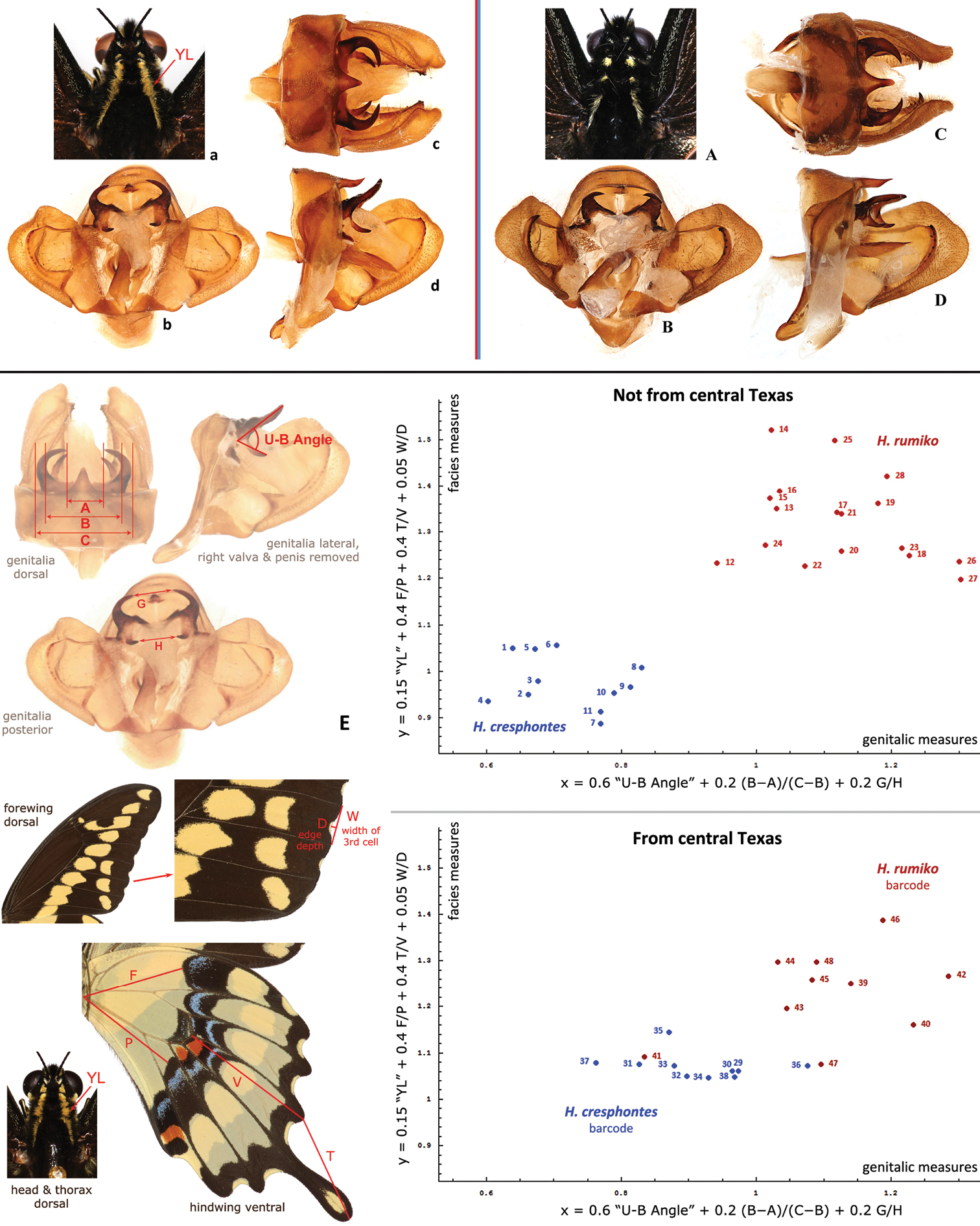
|
||
|
Neck pattern, male genitalia, and morphometrics. a–d H. rumiko, paratype, Mexico: Baja California Sur: Buena Vista, 1-Oct-1981, leg. D. Faulkner & F. Andrews, genitalia KS017 [SDMC] A–D H. cresphontes, USA: Georgia: Clark Co. July 2009, genitalia KS009 E Morphometric measurements performed on genitalia and facies and plotted in two dimensions. Horizontal axis is a weighted average of the three genitalic measures: 0.6*”U-B Angle” + 0.2* (B−A)/(C−B) + 0.2*G/H. “U-B Angle” is measured in radians. Vertical axis is a weighted average of the four facies measures: 0.15*”YL” + 0.4*F/P + 0.4*T/V + 0.05 W/D, where “YL” is equal to 0 or 1, if yellow line on the neck is separated into spots or continuous, respectively. Measured distances are indicated on the illustrations. Each of the two (genitalic and facies) linear combinations of measures completely segregates H. rumiko (red points) from H. cresphontes (blue points) specimens (not from central Texas) with a hiatus. Even a single measure “U-B Angle” identifies all specimens correctly, except #12, which has a brachium strongly curved dorsad. Specimen localities: H. cresphontes: 1. GA: Clark Co.; 2. NY: Niagra Co., Lockport; 3. NC: Carteret Co.; 4. IN: Kosciusko Co., Silver Lake; 5. WI: Sauk Co., Sauk City; 6. LA: St. John Pa., Edgard; 7. AR: Osceola; 8. OK: Marshall Co., Lake Texoma; 9. FL: Okeechobee Co., Fort Drum; 10. OH: Montgomery Co., Dayton; 11. PA: York Co., Pinchot State Park. H. rumiko: 12. AZ: Maricopa Co., North Phoenix; 13. AZ: Santa Cruz Co., Sycamore Canyon; 14. CA: Imperial Co.; 15. MX: Veracruz, Fortin de las Flores; 16. MX: Oaxaca, Yangul; 17. Costa Rica: Puntarenas, San Antonio; 18. MX: Tamaulipas, Gomez Farias; 19. MX: Colima, Colima; 20. MX: Sonora; 21. MX: Yukatan, Merida; 22. MX: Morelos, Rancho Viejo; 23. MX: BCS, Buena Vista; 24. MX: Jalisco, Ajajic; 25. CA: San Diego Co., La Jolla; 26. MX: Quintana Roo, nr. X-Can; 27. TX: Val Verde Co., Del Rio; 28. CA: San Diego Co., Pauma Valley. Central Texas specimens are from Bexar (33–38, 42–48), Williamson (39–41), Travis (31, 32), Bastrop (30), and Brazos (29) Counties. Voucher codes for these specimens are: 29. NVG-2236; 30. -2299; 31. -2300; 32. -2174; 33. -2192; 34. -2196; 35. -2205; 36. -2209; 37. -2210; 38. -2216; 39. -2301; 40. -2225; 41. -2229; 42. -2191; 43. -2197; 44. -2204; 45. -2208; 46. -2211; 47. -2215; 48. -2218. Species (color on the plot) is assigned to central Texas specimens by COI barcode. See Supplementary Table 1 for more data. Specimens 36 and 41 are apparent hybrids or the results of introgression. |